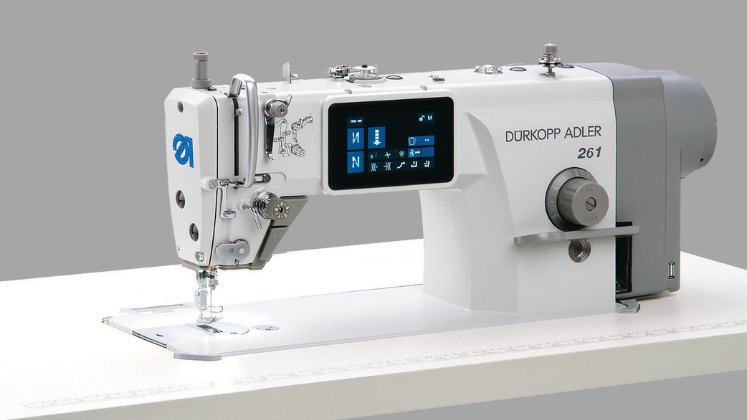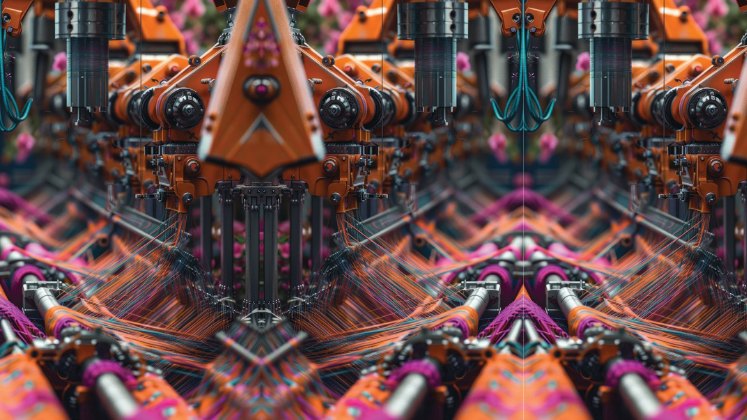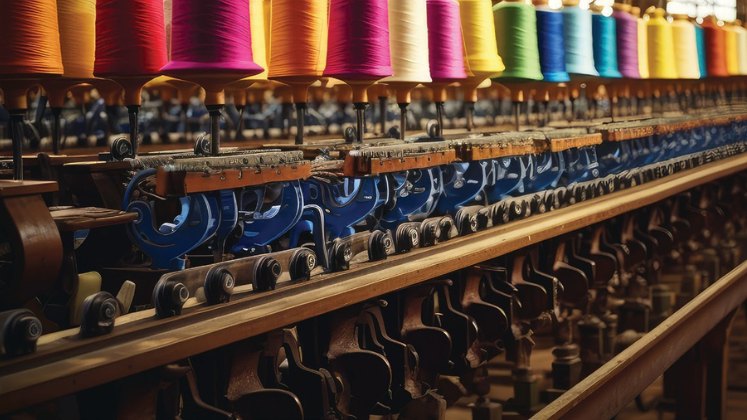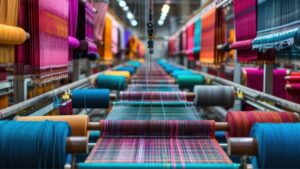‘A stitch in time saves nine’ and India’s textile machinery sector is working hard to make every stitch smarter, faster and more sustainable. At a time when global textile trade faces disruptions, rising tariffs and shrinking bulk orders, Indian machinery manufacturers are banking on innovation and the vast US $ 120 billion domestic market to fuel their next phase of growth. Automation, digitalisation and sustainability are no longer buzzwords but necessities, as labour shortages and the growing demand for smaller, customised orders reshape the way garments are produced.
From AI-enabled sewing machines that adjust themselves to fabric in real time, to advanced embroidery systems with multi-functional attachments and eco-friendly washers that save millions of litres of water, manufacturers are pushing the boundaries of technology to give India’s textile industry a competitive edge. The domestic market, once seen as secondary to exports, has now become the driving force, offering enough scale and diversity to offset challenges such as the United States imposing 50% tariffs on Indian textile imports.
The Indian textile machinery market itself is on the rise. It stood at US $ 1.14 billion in 2024 and could grow to US $ 2.02 billion by 2033, with an annual growth of about 6%, says IMARC Group.
| US $ 14 Billion
The Indian textile machinery market itself is on the rise. It stood at US $ 1.14 billion in 2024 and could grow to US $ 2.02 billion by 2033, with an annual growth of about 6%. |
The industry’s transformation is also being shaped by shifting buyer behaviour. Large-volume orders that once defined the sector are shrinking as brands and consumers increasingly demand uniqueness, smaller quantities and faster turnaround. Manufacturers now face the challenge of equipping themselves with digital tools, advanced machines and skilled manpower to handle more styles in less time.
We got in touch with top machine makers to find out how their recent launches are helping them explore opportunities in the local market.

We found out how top machine makers such as Jack, Bullmer, Dürkopp Adler, Strobel, PFAFF (SGSB Co. Ltd.), GEMINI (Lectra), WUZU International, Textile Technologies, AVA Aura, EH Turel, Fabcare and Pioneer are rolling out new products to tap the booming local market.
Innovations That Tackle Industry Challenges Head-On
As India’s apparel industry pushes for speed, efficiency and lower costs, machine suppliers and technology providers are rolling out smarter, more automated solutions.
For instance, Harsh Agarwal, Director, MRA Sons, one of the leading importers of industrial sewing machines with an annual turnover of nearly Rs. 300 crore (US $ 34 million), spoke about the Jack A4C NTB, a computerised lockstitch machine. He explained that the machine has an AI-based ‘Nine-Brain’ chip, which uses 200,000 fabric samples and makes 10,000 calculations per second to set the right fabric-feeding force. It works with the 0-degree Thread Path Technology to feed, wind and catch the thread more precisely. According to him, this reduces thread tension by about 30%, lowers thread breakage by 80% and increases output by nearly 5%.

Harsh also spoke about Jack Urus, a high-speed cross seam machine. He said the machine uses AI to sense changes in fabric position in real time and adjusts the balance between pressing force and feeding force. This allows it to handle different joints of thick, thin, elastic or hard fabrics at full speed without slowing down. The ‘Presser Foot Transformer’ feature can detect pressure changes 32,000 times per second using over one million data models, giving a very quick response.
Adding to this, Sumeet Gupta, Director, Ram Lalla Group, a company that deals in sewing and textile machines, highlighted the Bruce X5 Power Saving Overclock Machine. He said the model is designed for efficiency, with performance improvements of at least 25% and power savings of up to 71%. It is suitable for both light and heavy materials, offers stable performance and comes with efficient oil control. The machine has a fully covered needle bar structure and coaxial driving, which reduces torque to make sewing faster, more stable and more durable.
Other machine leaders are also stepping in to support the sector’s evolving needs. Bullmer’s Procut D 8001 S cutting machine offers easy programming of cutter parameters, optional drilling and marking and the ability to program simple pieces directly on the cutter. It uses brushless linear motors on all axes, an automatic frequency-controlled lubrication system and a high-performance vacuum turbine for smooth, reliable operation.
Whereas, Dürkopp Adler’s DA- 650 sleeve setting machine allows programmable fullness values and fine adjustments via step motor-controlled belt transport, enabling it to handle even challenging sleeve heads and fabrics. The company’s other latest offerings include the DA-581 Automatic Eyelet Button Holers and the DA-755 S Speed Pocket Welt Machine.
Moving on, Strobel’s VEB200-2 single thread double blindstitch machine is designed for demanding fabrics, from fine to medium quality. It creates a hidden blindstitch seam between fabric layers, maintaining excellent directional stability even at high speed. Precision sewing kinematics handle elastic and ultra-fine fabrics effortlessly, while lifetime-lubricated bearings and a durable drive ensure reliability. Operators can easily control functions such as the thread trimmer, soft start and lifting mode via a modern control panel, with optional digital display showing stitch depth to 0.01 mm accuracy.
Experts also highlighted the latest PFAFF (under SGSB Co. Ltd.,) machines including the high-speed PFAFF-2481 for label attaching and the PFAFF-2438 single-needle lockstitch machine with bottom and needle feed.
On the cutting room front, Vishal Sher, MD, Studio Next, a provider of CAD/CAM solutions, highlighted the Scope Pro – HX Series Spreader.
He said it is an intelligent automatic fabric spreading machine designed as a dual-purpose system, compatible with both rolls and folded fabric. The machine also offers a digital dashboard that provides real-time analysis of factory operations, helping management make informed decisions. By integrating IoT, it connects with an app, PC and production dashboards, creating a digital management hub.
Similarly, GEMINI (Lectra company) Creative STUDIO is pitched as a versatile solution for pattern making and product development, suitable for various product lines from apparel to home décor.
On the embroidery side, WUZU International, which deals in all types of textile machinery and spare parts, has launched Multi Head Computer Embroidery Machine that comes with sequin or cording attachment devices and speed variants of 1300 rpm, 1600 rpm and 1800 rpm. It is equipped with the Dahao New Touch Screen A18/A58/A8 Mate Smart Computer, available with or without a motorised trimmer and UTC, along with a Dahao Servo Motor for the main shaft and XY movement supported by a fan cooling system. The embroidery area ranges from 100 mm to 500 mm, with options of 4, 6, 9, 12 or 15 colours/needles.
“Pantograph/frame width varies from 1000 mm to 1600 mm and the machine can have 1 to 30 heads depending on the model. It features Japanese 1.6/1.0 jumbo black-coated high-speed hooks, high-speed heads with double cam triple lever systems and either an independent motorised or normal pressure foot system,” highlighted Mohammed Aoun, Director, Wuzu.
Similarly, Textile Technologies, a supplier of specialised embroidery machines, showcased the Maya Star Mixed-Chenille High Speed machine. It combines high-speed chenille (chain stitch) and high-speed flat embroidery, controlled by a Dahao A9 Mate with a 17-inch touchscreen. The use of X-Y servo motors makes chenille embroidery softer and more precise, with 10 different needle heights for automatic adjustment. The machine supports towel embroidery and chain stitch embroidery, with automatic colour change, auto-trimming and thread break detection functions.
“Its simple and accurate structure reduces mechanical wear and tear, while running at speeds of up to 1200 rpm. The machine can be used across garments, home textiles, lace, shawls, stoles and suits,” said Vineet Mittra, GM, Textile Technologies.
Talking about Chinese embroidery machines, Deepak Choudhary, CEO, AVA Aura, said their models come with a range of optional devices and attachments including sequins (single, twin, or four), boring, cording, glass beads, laser, thick yarn and quad-colour sequins. These machines have a stitch length of 0.1 to 12.7 mm, a memory capacity of 10 million stitches and run on 3-phase 220V/380V power (single phase available on request).
Moving to the printing solutions, EH Turel offers The XSTREAM plotter which is a plug-and-play machine that requires minimal maintenance. It can print 75-140 sqm/hr and supports roll widths of 180-220 cm. The XSTREAM JET version features an industrial inkjet system for even higher speed and performance, printing 45-90 sqm/hr.
The homegrown company also offers The IDEA plotter, another versatile option, printing 35-60 sqm/hr with roll widths of 180-220 cm. It shares features like 24-hour unattended printing, paper tension control, electronic end-of-paper warning, automatic shutdown in case of jams and USB compatibility with CAD systems. It handles rolls up to 35 kg and supports different paper types.
Betting Big on India’s Domestic Market
Machinery manufacturers are bullish about India’s US $ 120 billion domestic market, where the growing push for automation is creating massive opportunities. With a market this big and vibrant, they believe India has enough strength to absorb the shock of 50% tariffs by US.
“Automation is what everyone is looking at now because labour has become scarce,” said Sumeet from Ram Lalla. “Earlier, people thought they would first get orders and then invest in automation. But today the market works differently, you need to invest in machines and automation first and only then will you get the orders. Big players like Shahi and other leading exporters follow this approach. They plan, set up the systems, showcase their capabilities and then secure the orders,” said Harsh from MRA Sons.
| Machine makers mentioned that big volume orders are shrinking as fashion changes faster. Customers now want uniqueness and smaller quantities. Earlier, one order might be 5,000 pieces in two colours, but now it’s the same 5,000 pieces split into 20 smaller orders in different colours and styles. To handle this, the industry needs better machines, skilled workers and digital tools. |
Echoing the sentiments, Vishal of Studio Next noted, “Now, with shrinking profits and rising competition, efficiency has become critical. You can’t afford wastage anymore, and that’s why the industry is turning to automation.”
He explained that adoption of new technology often starts slow, especially when costs are high. “Take CAD systems, for example. I was among the first to identify the domestic market for CAD and today we have 7,000 customers. That growth has mainly come from domestic players because exporters are limited in number. These 7,000 include everyone—from small units making 500-1,000 garments a day to bigger ones producing 50,000 garments daily,” he said.
Experts also noted the increasing support from state governments for the local textile and apparel industry.
“In Uttar Pradesh, for example, textile and garment units can receive capital subsidies of up to 25% of their investment in plant and machinery, and MSMEs also benefit from central schemes. In Meerut, we have supplied over 1,000 machines in the past two years, and our machines are also installed in Muzaffarnagar, Saharanpur, Bareilly, Shajahanpur, Lucknow, Azamgarh and Benaras,” said Mohammed.

He further explained that Wuzu has given a proposal to the government to set up a full industrial set-up and ecosystem for textile machinery in India. “We have pledged Rs. 30- 35 crore for this, but such set-ups, especially with supporting ancillary units, must come up in India. Otherwise, we will continue to depend on imports from countries like China,” he said.
Machine makers mentioned that big volume orders are shrinking as fashion changes faster. Customers now want uniqueness and smaller quantities. Earlier, one order might be 5,000 pieces in two colours, but now it’s the same 5,000 pieces split into 20 smaller orders in different colours and styles. To handle this, the industry needs better machines, skilled workers and digital tools. However, experts pointed out that India’s bigger challenge is unstable demand. Large players can expand because they have steady orders, but mid- and small-sized players face staggered demand and cannot grow much.
India is a big market, but even a single holiday can stop orders for 15 days until workers return. This seasonality makes it hard to recover machine costs.
Machine makers also rue the slow adoption of AI in India. Meanwhile, the government’s push to promote domestic manufacturing in the textile sector has created concerns amongst a certain section of industry leaders. India imports nearly 90% of its weaving machines and companies fear that new regulations will slow down growth and expansion.
The Ministry of Heavy Industries announced that from August 28, 2025, the Bureau of Indian Standards (BIS) mark will be mandatory for several types of textile machinery, including weaving and embroidery machines. But associations like the Federation of Gujarat Weavers Welfare Association (FOGWWA) have already requested the government to postpone the implementation until March 2027.

Industry voices argue that while the idea of boosting local machine manufacturing is right, the infrastructure is not ready. “It is painful to say, but India is far behind countries like China in terms of industrial areas, logistics, and support. Without such an ecosystem, machine manufacturing here is very difficult,” said one industry leader.
Others pointed out that the cost of BIS certification is very high. They also highlighted other challenges, such as the lack of local testing facilities and the fact that BIS officials are reluctant to certify machines made in China, which remains the global hub. “Instead of making certification mandatory, the government should give incentives, like extra subsidies, for BIS-certified suppliers. That would encourage adoption without burdening the industry,” said Vineet Mittra.
Despite these challenges, machine makers are quietly at work shaping the next chapter of India’s textile story.









